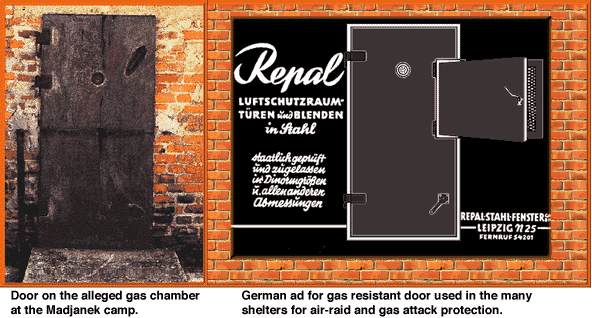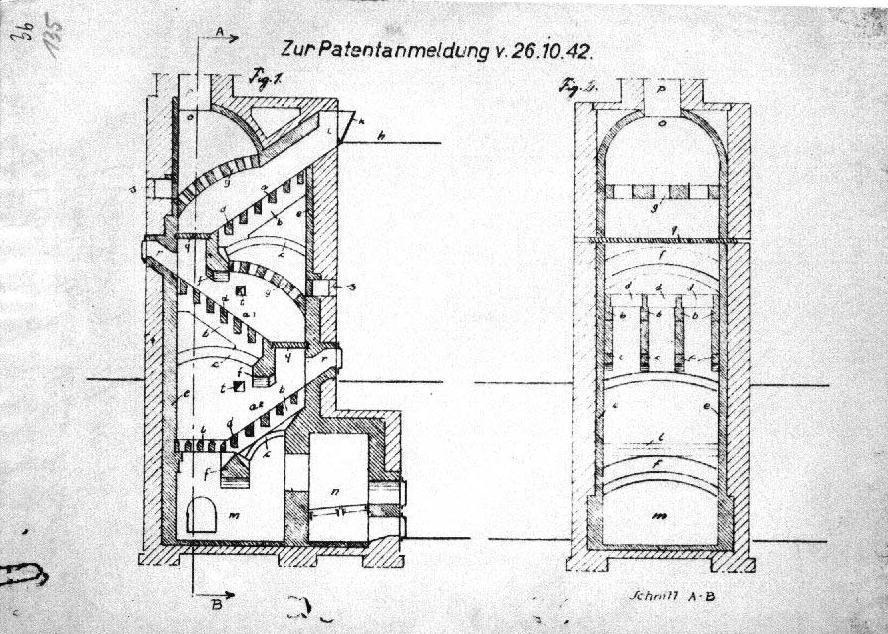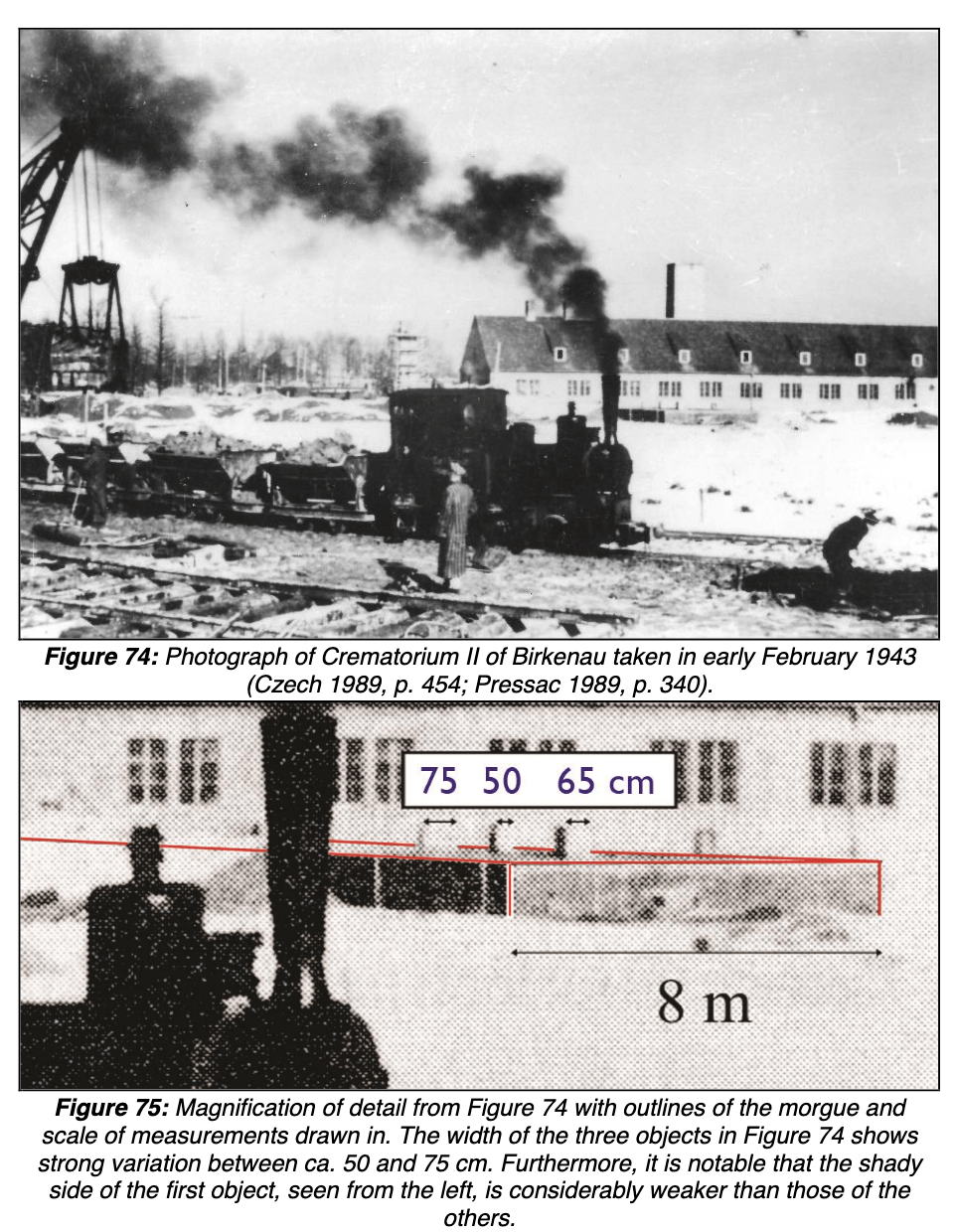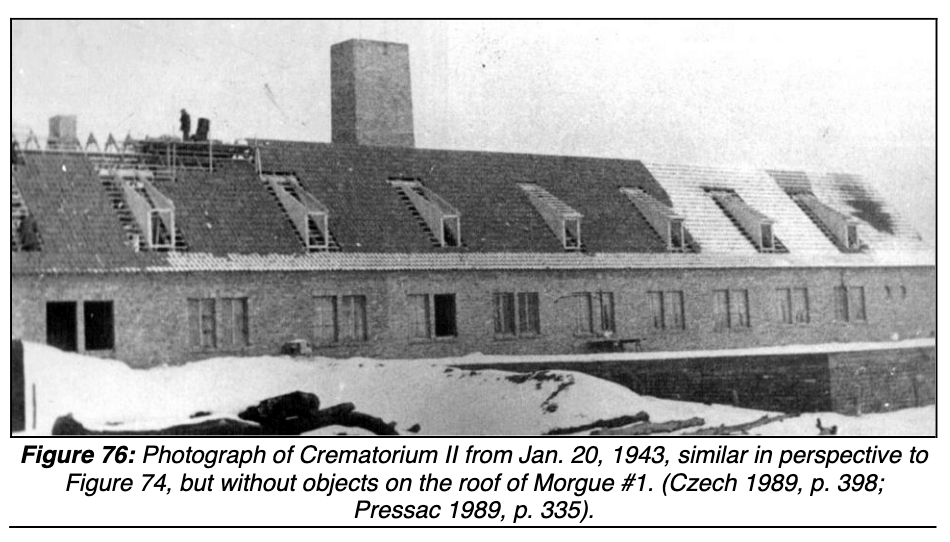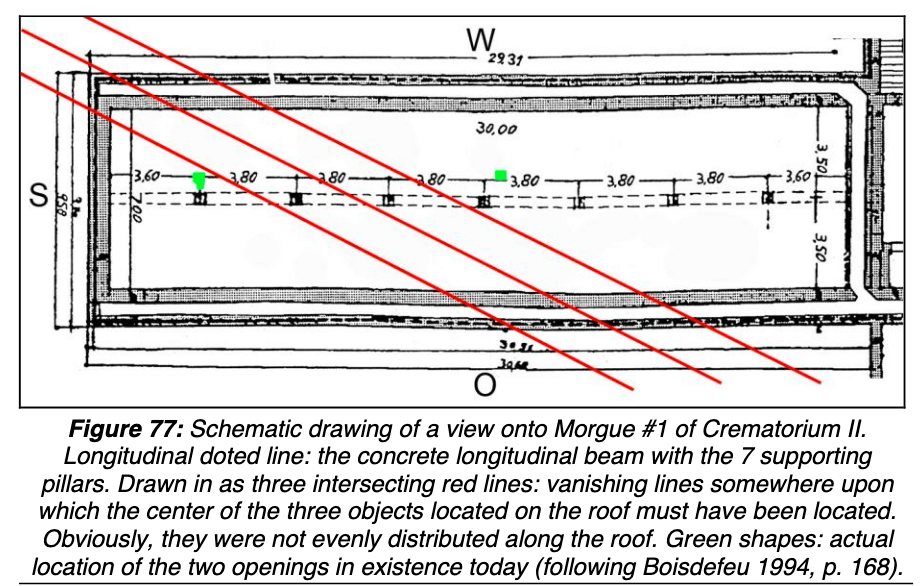4. The Objects on the “Train Photograph”
In their effort to demonstrate the presence of the four presumed holes on the roof slab of morgue 1, the authors utilize three photographs – one terrestrial and two aerial.
The first is the well-known shot from the “Kamann” series of February 1943, which has been published and analyzed by Jean-Claude Pressac.[19] Because of the presence in the foreground of a small locomotive with several little cars, the authors call it the “Train Photograph”.[20]
In its background, this photograph shows morgue 1 of crematorium II, on top of which there are four unidentifiable objects, which D. Keren and his colleagues take three to be the chimneys for the introduction of Zyklon B. As results from their Fig. 4 on p. 80, they claim to have identified the first two chimneys, starting from south; the third one is said to be “entirely occluded by the smokestack” of the engine (p. 71) whereas the fourth appears for them “just to the left of a locomotive’s smokestack” (p. 71, see document 2a.). The analysis of this photograph by the authors is extremely superficial and skirts purposely many essential elements.
1. First of all, let us state that the presence of chimney # 3 behind the smokestack of the locomotive is pure conjecture and does not result from the photograph.
2. Secondly, the claim that the three indistinct objects, which one can see on the roof slab of morgue 1, are introduction chimneys for Zyklon B, is likewise an undemonstrated and not demonstrable assumption, which is even, as we shall see under item 7, contrary to the evidence.
The authors attempt to lend weight to their claim by bringing in two likewise known aerial photographs of the Birkenau area taken on 25 August 1944, with which I shall deal in the next section. Anticipating their later arguments, they in fact state the following conclusion:
“That the holes alternate in Crematorium II is supported by the aerial photograph, the Train Photograph, the physical findings, and Tauber’s testimony:” (p. 72)
3. Actually, the indistinct objects taken by the authors to be chimneys 1 and 2 for Zyklon B are both situated on the eastern half of the roof of the mortuary, as shown by the corresponding diagram (see document 2b), which is at variance with their basic thesis.
4. If one calculates the position of objects 1 and 2 along the median of the surface of the morgue, it results from this diagram that they stood at 7.2 and 10.5 m from the southern end of the morgue. This is fully borne out by the diagram prepared by Provan on which I have marked by numbers 1 and 2 the position of the respective objects (see document 2i).
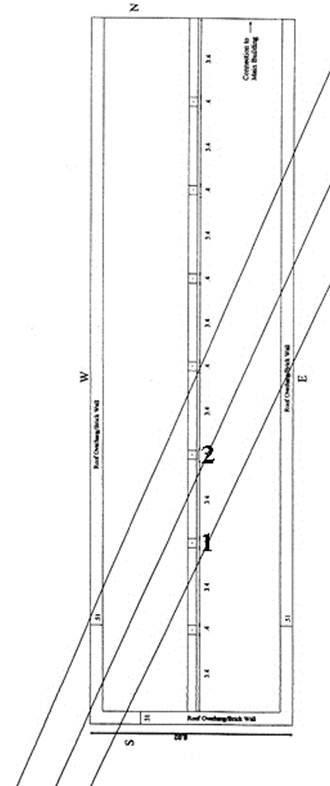
Document 2i: Triangulation diagram for the objects #1 and #2 on the roof of morgue 1 of crematorium II, drawn by C.D. Provan.[21] My numbers 1 and 2 mark the position of the respective objects. The third (left-most) line refers to an object, which D. Keren et al. do not consider to be a chimney for Zyklon B.
This means that object 1 is situated next to pillar # 2 and east of the central beam, whereas D. Keren et al. claim that the alleged chimney 1 is next to pillar # 1 and west of the central beam. Object 2 is about 3.3 m away from object 1, whereas, according to D. Keren et al., the alleged chimneys 1 and 2 should be located about 7.6 m apart. In document 1a, I have indicated on the diagram of D. Keren et al. the position of objects 1 and 2 with respect to their alleged Zyklon B chimneys 1 and 2.
5. According to D. Keren et al., object 4 should be located slightly in front of the last pillar of the morgue, hence some 4 m from the wall of the crematorium. Instead, it is touching the wall and its height is therefore 45 cm – half the distance between the pair of windows to its left and the plane of the morgue. The windows of the crematorium were, in fact, some 90 cm above the plane of morgue 1, as shown by drawing 1173-1174 (p)[22] and confirmed by the “Train Photograph”; thus the height of the object is half this distance.
If instead the object had been at the position indicated by the authors, it would be even lower because of the perspective. Already on plan 936 of January 15, 1942,[23] and in the later ones as well, a layer of earth had been specified for the top of morgue 1; plan 109/16a dated October 9, 1943, gives the exact thickness of this layer: 50 cm.[24] It follows that object 4, rising less than 50 cm above the concrete surface of the morgue, would have been buried in this layer of earth, therefore it could not have been a chimney for Zyklon B.
6. To the left of object 2 is another object on that roof. But because it obviously has a noticeably different shading and shape and because it is located at an inconvenient location, D. Keren et al. simply claim that this can not be a Zyklon B chimney. But if we are certain that there is at least one object on that roof which is not a Zyklon B chimney, is it not possible that the objects 1, 2, and 4 were “other” objects as well?
7. What may these objects have been? The photograph in question does not allow us to solve this riddle, but there is another photograph, also from the Kamann series, taken a few weeks earlier, which shows the morgue of crematorium II in greater detail (see document 3). On this photograph the alleged chimneys for Zyklon B do not appear at all. In my article cited initially I have already demonstrated that the hypothesis of a creation of holes in the ceiling of morgue 1 for the introduction of Zyklon B is technically absurd and also in total disagreement with one of the principal tenets of the official thesis shared also by the authors.[25]
In the photograph just mentioned, there is, on the roof of the morgue, an object with square sides, leaning against the wall to the left of the third pair of windows, which seems to be made up by a pile of boxes (see documents 3 and 3a). It is odd that the position of this object corresponds exactly to the alleged chimney 4 of the “Train Photograph”. We may have here an alternative explanation of chimney # 4.
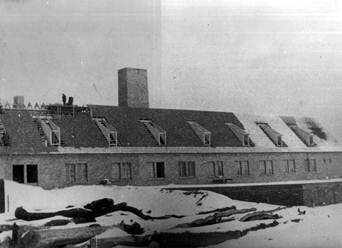
Document 3: Photography of crematorium II in Birkenau, January 1943.[26]

Document 3a: Section enlargement of doc. 3.
8. Let us move on to the other two objects. D. Keren et al. assume as an established fact that they were rectangular in shape and answer D. Irving’s hypotheses as follows:
“David Irving has speculated that the holes are really ‘drums containing sealant,’ but it is obvious that this cannot be the case: a cylindrical object would produce a gradual light pattern, while the objects above display a sharp change between uniform light and uniform shadow.” (p. 71)
Actually, this is anything but “obvious.” As is shown by an enlargement of objects 1 and 2, they have a shape that is rounded at top and bottom (see documents 2c and 2d), which is absolutely incompatible with the shadow zones of a parallelepiped; this also results from a comparison with one of the ventilation chimneys of the crematorium (document 2e) and the chimney of the ovens (document 2f).
It is therefore clear that the objects have a cylindrical shape.[27] But an object, cylindrical in shape, appears clearly just in front of the south wall of the morgue (see document 2g). Its dimensions, considering that the cylinder is right against the wall, are compatible with the two objects located on top of the morgue. We have here, no doubt, drums that were used during the construction. A similar cylinder, identifiable as a metal barrel, appears also in a photograph, which shows the erection of the chimney of crematorium III (document 2h). David Irving’s hypothesis therefore remains the most probable one.


